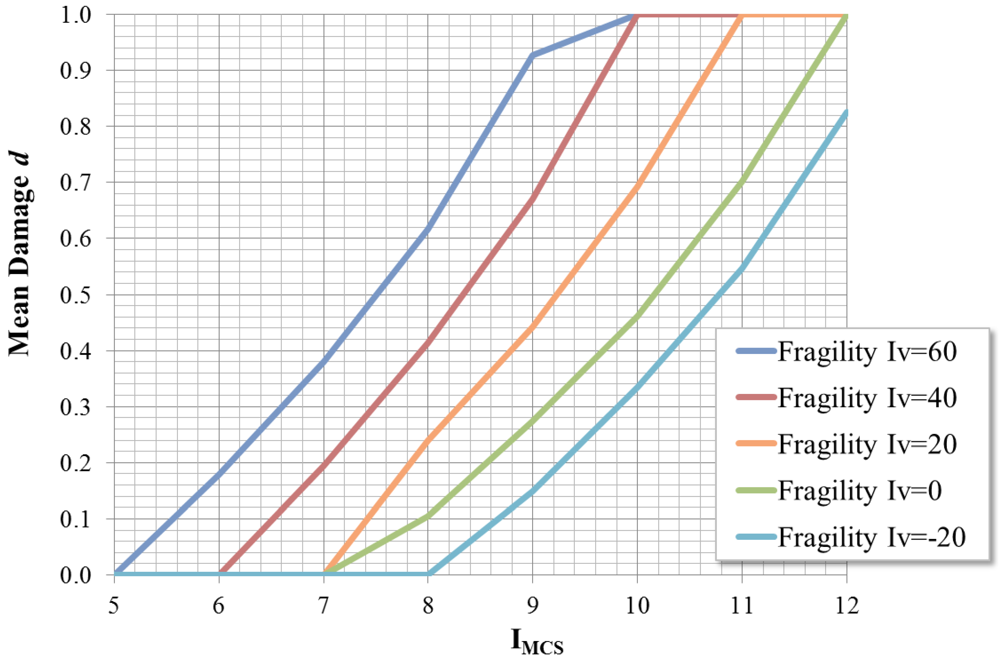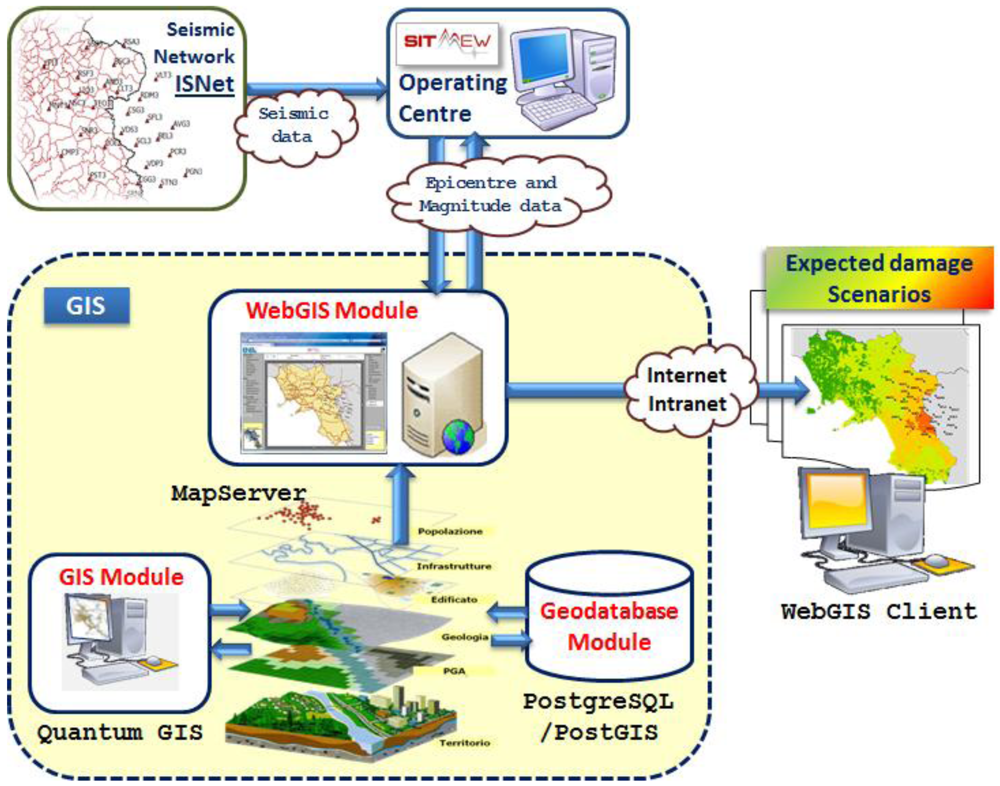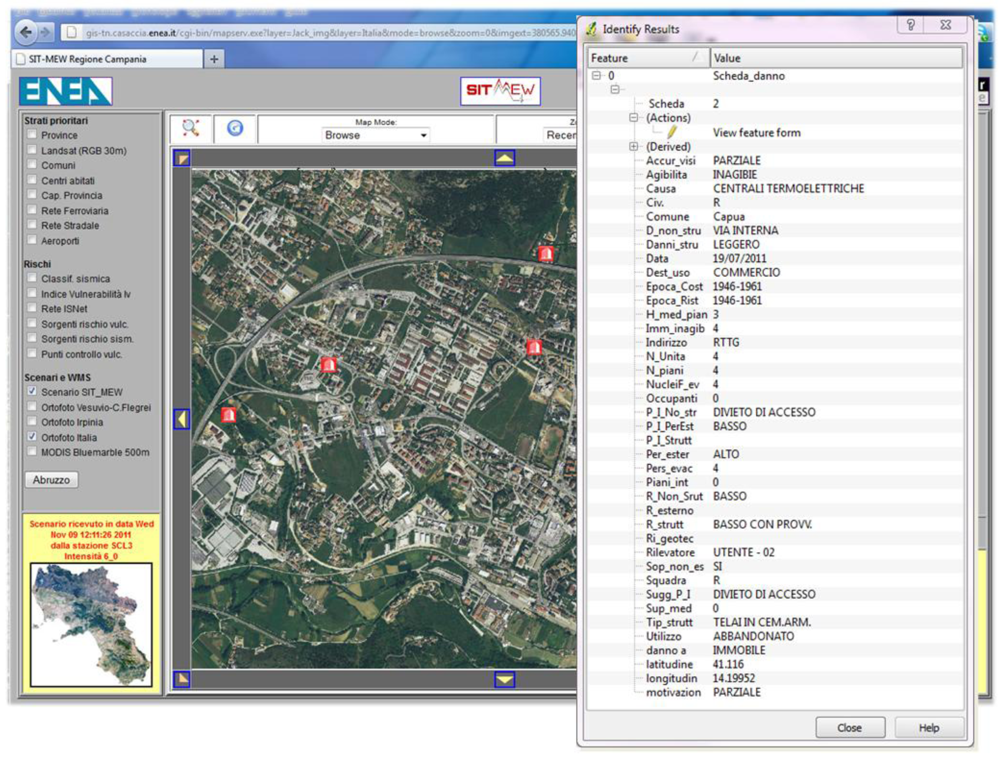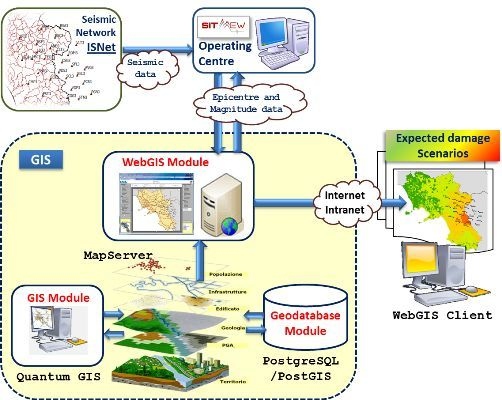Collaborative Open Source Geospatial Tools and Maps Supporting the Response Planning to Disastrous Earthquake Events
Abstract
:1. Introduction
2. Materials and Methods
2.1. The Study Case

2.2. The Methodology
- estimate the earthquake ground motion attenuation with the distance from the seismic epicenter;
- evaluate local site effects of soil amplification;
- estimate the damages to the facilities inventories.


2.3. Mapping Structures Vulnerability
| Construction age | IV | ||
|---|---|---|---|
| Masonry | RC | ||
| 1 | Before 1919 | 50 | - |
| 2 | 1919–1945 | 40 | - |
| 3 | 1946–1961 | 30 | 20 |
| 4 | 1962–1971 | 30 | 20 |
| 5 | 1972–1981 | 20 | 20 |
| 6 | 1982–1991 | 20 | 0 |
| 7 | After 1991 | 20 | 0 |
| Age | <1919 | 1919–1945 | 1946–1961 | 1962–1971 | 1972–1981 | 1982–1991 | >1991 | |
|---|---|---|---|---|---|---|---|---|
| No. of storeys | ||||||||
| 1 | 0 | 0 | 0 | 0 | 0 | –6 | –6 | |
| 2 | +5 | +5 | +5 | +5 | +5 | 0 | 0 | |
| 3 | +5 | +5 | +5 | +5 | +5 | 0 | 0 | |
| >4 | +10 | +10 | +10 | +10 | +10 | +6 | +6 | |

2.4. Mapping Expected Damage Scenarios



3. The WebGIS System
- Geodatabase Module (by using PostgreSQL/PostGIS);
- GIS Module (by using Quantum GIS);
- WebGIS Module (by using MapServer).

- Basic GIS Layers (Italian DBPrior10K: Administrative boundaries, road network, railways, hydrograph, etc.);
- Thematic Maps (hydrology, geomorphology, seismic classification, etc.);
- 1:25.000 Cartography;
- Census data (ISTAT);
- Digital Terrain Model (DTM, 20 m ground spacing);
- Geographic location and data of ISNet seismic sensors;
- PGA (Peak Ground Acceleration) distribution maps;
- Data from parametric catalogue of damaging earthquakes in Italy (INGV).

3.1. The Post-Event Management

4. Conclusions and Future Developments
Acknowledgments
References
- National Research Council–Board on Earth Sciences and Resources, Successful Response Starts with a Map: Improving Geospatial Support for Disaster Management; The National Academies Press: Washington, DC, USA, 2007.
- Goodchild, M.F. Citizens as sensors: The world of volunteered geography. GeoJournal 2007, 69, 211–221. [Google Scholar]
- Cova, T.J. GIS in Emergency Management. In Geographical Information Systems: Principles, Techniques, Applications, and Management; Longley, P.A., Goodchild, M.F., Maguire, D.J., Rhind, D.W., Eds.; John Wiley & Sons: New York, NY, USA, 1999; pp. 845–858. [Google Scholar]
- Charvat, K.; Kubicek, P.; Talhofer, V.; Konecny, M.; Jezek, J. Spatial Data Infrastructure and Geo-Visualization in Emergency Management. In Resilience of Cities to Terrorist and Other Threats; Pasman, H., Kirillov, I., Eds.; Springer: Dordrecht, The Netherlands, 2008; pp. 443–473. [Google Scholar]
- Heipke, C. Crowdsourcing geospatial data. ISPRS J. Photogramm. Remote Sens. 2010, 65, 550–557. [Google Scholar]
- Schoier, G.; Borruso, G. Individual Movements and Geographical Data Mining. Clustering Algorithms for Highlighting Hotspots in Personal Navigation Routes. In Lecture Notes in Computer Science; Murgante, B., Gervasi, O., Iglesias, A., Taniar, D., Apduha, B.O., Eds.; Springer: Heidelberg, Germany, 2011; Volume 6783, pp. 376–391. [Google Scholar]
- De Longueville, B. Community-based geoportals: The next generation? Concepts and methods for the geospatial Web 2.0. Comput. Environ. Urban Syst. 2010, 34, 299–308. [Google Scholar] [CrossRef]
- Laituri, M.; Kodrich, K. On line disaster response community: People as sensors of high magnitude disasters using internet GIS. Sensors 2008, 8, 3037–3055. [Google Scholar]
- Tilio, L.; Scorza, F.; Lanza, V.; Murgante, B. Open Source Resources and Web 2.0 Potentialities for a New Democratic Approach in Programming Practices. In Lecture Notes in Artificial Intelligence; Springer-Verlag: Berlin, Germany, 2009; Volume 5736, pp. 228–237. [Google Scholar]
- Della Rocca, A.B.; Fattoruso, G.; Lo Curzio, S.; Pasanisi, F.; Pica, R.; Peloso, A.; Pollino, M.; Tebano, C.; Trocciola, A.; De Chiara, D.; Tortora, G. SISI Project: Developing GIS-Based Tools for Vulnerability Assessment. In Visual Information Systems. Web-Based Visual Information Search and Management; Sebillo, M., Vitiello, G., Schaferer, G., Eds.; Springer: Heidelberg, Germany, 2008; Volume I, pp. 327–330. [Google Scholar]
- Marcheggiani, E.; Galli, A.; Gulinck, H. The Characterisation of “Living” Landscapes: The Role of Mixed Descriptors and Volunteering Geographic Information. In Lecture Notes in Computer Science; Murgante, B., Gervasi, O., Iglesias, A., Taniar, D., Apduha, B.O., Eds.; Springer: Berlin, Germany, 2011; Volume 6782, pp. 369–380. [Google Scholar]
- Falck, C.; Ramatschi, M.; Subarya, C.; Bartsch, M.; Merx, A.; Hoeberechts, J.; Schmidt, G. Near real-time GPS applications for Tsunami early warning systems. Nat. Hazards Earth Syst. Sci. 2010, 10, 181–189. [Google Scholar]
- Gasparini, P.; Manfredi, G.; Zschau, J. Earthquake early warning as a tool for improving society's resilience and crisis response. Soil Dyn. Earthq. Eng. 2011, 31, 267–270. [Google Scholar]
- Nakamura, Y.; Saita, J.; Sato, T. On an earthquake early warning system (EEW) and its applications. Soil Dyn. Earthq. Eng. 2011, 31, 127–136. [Google Scholar]
- Satriano, C.; Wu, Y.-M.; Zollo, A.; Kanamori, H. Earthquake early warning: Concepts, methods and physical grounds. Soil Dyn. Earthq. Eng. 2011, 31, 106–118. [Google Scholar]
- Wald, D.J.; Worden, B.C.; Quitoriano, V.; Pankow, K.L. ShakeMap Manual: Technical Manual, User’s Guide and Software Guide. USGS. 2006. Available online: http://pubs.usgs.gov/tm/2005/12A01/ (accessed on 4 may 2012).
- Allen, R.M. The ElarmS Earthquake Early Warning Methodology and Application across California. In Earthquake Early Warning Systems; Gasparini, P., Manfredi, G., Zschau, J., Eds.; 2007; pp. 21–43. [Google Scholar]
- Marketos, G.; Theodoridis, Y.; Kalogeras, I.S. Seismological data warehousing and mining: A survey. Int. J. Data Warehous. Min. 2008, 4, 1–16. [Google Scholar]
- Federal Emergency Management Agency FEMA 2008, HAZUS-MH Estimated Annualized Earthquake Losses for the United States; FEMA: Washington, DC, USA, 2008.
- Theodoridis, Y. Seismo-Surfer: A Prototype for Collecting, Querying, and Mining Seismic Data. In PCI 2001. Lecture Notes in Computer Science; Springer: Berlin, Germany, 2003; Volume 2563, pp. 159–171. [Google Scholar]
- Andrienko, N.; Andrienko, G. Intelligent visualization and information presentation for civil crisis management. Trans. GIS 2007, 11, 889–909. [Google Scholar]
- Pollino, M.; Fattoruso, G.; Della Rocca, A.B.; La Porta, L.; Lo Curzio, S.; Arolchi, A.; James, V.; Pascale, C. An Open Source GIS System for Earthquake Early Warning and Post-Event Emergency Management. In Lecture Notes in Computer Science; Murgante, B., Gervasi, O., Iglesias, A., Taniar, D., Apduha, B.O., Eds.; Springer: Berlin/Heidelberg, Germany, 2011; Volume 6783, pp. 376–391. [Google Scholar]
- Lantada, N.; Pujades, L.G.; Barbat, A.H. Vulnerability index and capacity spectrum based methods for urban seismic risk evaluation. Nat. Hazards Earth Syst. Sci. 2009, 51, 501–524. [Google Scholar]
- Borcherdt, R.D. Influence of Local Geology in the San Francisco Bay Region, California on Ground Motions Generated by the Loma Prieta Earthquake of October 17, 1989. In Proceedings of the International Symposium on Safety of Urban Life and Facilities, Tokyo, Japan, 1–2 November 1990; pp. 1–35.
- Aki, K. Local Site Effects on Strong Ground Motion. In Proceedings of the ASCE Conference on Earthquake Engineering and Soil Dynamics; Rolla, MO, USA, 1998; I, pp. 103–155. [Google Scholar]
- Kiremidjian, A.S.; King, S.A.; Sugito, M.; Shah, H.C. Simple Site-Dependent Ground Motion Parameters for the San Francisco Bay Region. In The John A. Blume earthquake Engineering Center Report No. 97; Stanford University: Stanford, CA, USA, 1991. [Google Scholar]
- Lutz, K.A.; Kirernidjian, A.S. A Generalized Semi-Markov Process for Modelling Spatially and Temporally Dependent Earthquakes. In The John A. Blume earthquake Engineering Center Report No. 97; Stanford University: Stanford, CA, USA, 1993. [Google Scholar]
- Decanini, L.D.; Mollaioli, F. Formulation of elastic earthquake input energy spectra. Earthq. Eng. Struct. Dyn. 1998, 27, 1503–1522. [Google Scholar]
- Decanini, L.D.; Mollaioli, F. An energy-based methodology for the assessment of seismic demand. Soil Dyn. Earthq. Eng. 2001, 21, 113–137. [Google Scholar]
- Sabetta, F.; Pugliese, A. Estimation of response spectra and simulation of non-stationary earthquake ground motion. Bull. Seismol. Soc. Am. 1996, 86, 337–352. [Google Scholar]
- Lagomarsino, S.; Giovinazzi, S. Macroseismic and mechanical models for the vulnerability and damage assessment of current buildings. Bull. Earthq. Eng. 2006, 4, 415–443. [Google Scholar]
- Borfecchia, F.; De Cecco, L.; Pollino, M.; La Porta, L.; Lugari, A.; Martini, S.; Ristoratore, E.; Pascale, C. Active and passive remote sensing for supporting the evaluation of the urban seismic vulnerability. Ital. J. Remote Sens. 2010, 42, 129–141. [Google Scholar]
- Ramsey, P. The State of Open Source GIS. In Proceedings FOSS4G 2007 Conference, Vancouver, Canada, 12–16 September 2007; Available online: http://2007.foss4g.org/presentations/viewattachment.php?attachment_id=8 (accessed on 4 May 2012).
- Steiniger, S.; Bocher, E. An overview on current free and open source desktop GIS developments. Int. J. Geogr. Inf. Sci. 2009, 23, 1345–1370. [Google Scholar]
- Ramm, F. Crows Sourcing Geodata. In Proceedings FOSSGIS 2008, Freiburg, Germany, 1–3 April 2008; Available online: www.geofabrik.de/media/2009-09-08-crowdsourcing-geodata.pdf (accessed on 4 May 2012).
- Hudson-Smith, A.; Batty, M.; Crooks, A.; Milton, R. Mapping for the masses: Accessing Web 2.0 through crowdsourcing. Soc. Sci. Comput. Rev. 2009, 27, 524–538. [Google Scholar] [CrossRef]
© 2012 by the authors; licensee MDPI, Basel, Switzerland. This article is an open-access article distributed under the terms and conditions of the Creative Commons Attribution license (http://creativecommons.org/licenses/by/3.0/).
Share and Cite
Pollino, M.; Fattoruso, G.; La Porta, L.; Della Rocca, A.B.; James, V. Collaborative Open Source Geospatial Tools and Maps Supporting the Response Planning to Disastrous Earthquake Events. Future Internet 2012, 4, 451-468. https://doi.org/10.3390/fi4020451
Pollino M, Fattoruso G, La Porta L, Della Rocca AB, James V. Collaborative Open Source Geospatial Tools and Maps Supporting the Response Planning to Disastrous Earthquake Events. Future Internet. 2012; 4(2):451-468. https://doi.org/10.3390/fi4020451
Chicago/Turabian StylePollino, Maurizio, Grazia Fattoruso, Luigi La Porta, Antonio Bruno Della Rocca, and Valentina James. 2012. "Collaborative Open Source Geospatial Tools and Maps Supporting the Response Planning to Disastrous Earthquake Events" Future Internet 4, no. 2: 451-468. https://doi.org/10.3390/fi4020451
APA StylePollino, M., Fattoruso, G., La Porta, L., Della Rocca, A. B., & James, V. (2012). Collaborative Open Source Geospatial Tools and Maps Supporting the Response Planning to Disastrous Earthquake Events. Future Internet, 4(2), 451-468. https://doi.org/10.3390/fi4020451








